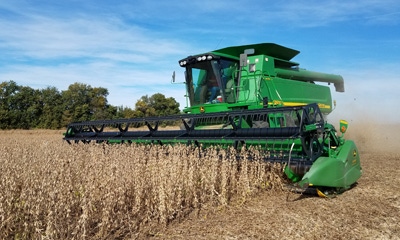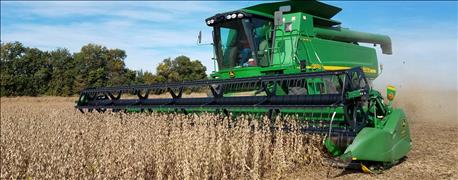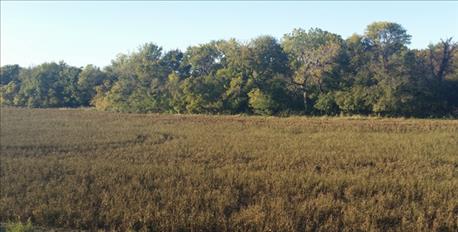
The summer of 2016 goes into the record books as the third-wettest on record, especially in southern Kansas, with steady rains at least once a week, many of them heavy.
That is good. Until it's not.
Across southern Kansas, rivers and creeks rose above flood stage at regular intervals, inundating fields and leaving cornfields with only tassels showing above standing water and soybean fields looking like lakes.
And rising water tables, along with the restoration of springs that haven't flowed in a couple of decades, have created surprises.

HARVEST IS ON: The soybean harvest was underway in earnest after successive days of warm weather and wind — with a break in the rain — by mid-October. Producer Paul Penner says this field of soybeans was "slimey" only a few days before combines rolled on Oct. 17. (Photo courtesy of Paul Penner.)
"My brother buried a tractor and had to get a grader to pull him out," says Sedgwick County farmer Mick Rausch. "He hit the stream created by a long-dormant spring that came back to life and just went down."
Mike Wallace, a technician with the Natural Resources Conservation Service in Wichita says producers hit with river and stream flooding have suffered total losses of fields that stood under water for days or weeks.
In fields that did drain, albeit slowly, farmers found themselves facing overripe corn, soybeans or grain sorghum, and deteriorating grain quality with a tough decision to make: Harvest in the mud or forgo the bushels.
If you found yourself among those who ventured into still-soft fields to harvest long overripe corn or beans on the verge of shattering, you likely have some choices to make in the coming days or weeks. How do you repair those ruts or, worse yet, the damage from equipment stuck in the mud that had to be pulled by heavier machinery, especially if you are committed to no-till farming practices.

FLOODED BEANS: This soybean field in the Slate Creek bottom near Wellington stood under water for several days during heavy rains in September.
'Unfortunately, some tillage is really the only way to get rid of deep roots or deep holes," says Wallace. "You can limit that, though, by only working on the areas that were damaged and not tilling the entire field."
For those farmers with a conservation contract that requires no tillage, a phone call to your local NRCS office may be necessary.
"There are regulations that can give producers a variance to help them repair damage to a field," he says.
Steve Swaffer, executive director of No-till on the Plains, says committed no-tillers will stay out of wet fields, and those who must go into fields to harvest will avoid tillage as a solution to mitigating damage.
Swaffer says he expects the vast majority of those producers will map the damaged areas of the field and take action to mitigate damage with plant growth.
"If you have ruts, you need to go back in as soon as you can and plant a cover crop that will help loosen that soil and prevent it from compaction. Unfortunately, the time frame to get anything growing before frost is slim, and you may have to take advantage of the first spring opportunity to plant.” He says growers should plant with the rut, not across it, using a mix of cool-season grasses and tillage plants such as turnips and radishes.
The good news, Swaffer says, is that all but the deepest ruts and holes will resolve with the natural heave of freeze and thaw during the coming winter.
Another option, if ground will be fallow through the winter, is to roll out hay, filling up mud holes or ruts with organic matter that will rapidly compost.
"Leftover round bales of prairie hay would be good for this kind of remediation because they will decompose quickly, filling in those spaces with organic matter," he says.
If you have to resort to tillage, he says, make it minimal.
"Till only where you absolutely have to," he says. "Do a very light disking or chiseling just in the rutted area. Or consider using a tool like a track packer, designed for repairing pivot tracks to fill in the ruts."
Ryan Speer, a regular presenter at No-till on the Plains and manager of Jacob Farms near Sedgwick, says he has been fighting wet fields all summer and fall.
"So far, we haven't had to go into a wet field," he says. "But we have sure had to work around wet spots. We have mostly sandy loam soils, and we've been in no-till and cover crops for decades, so we dry out pretty fast even in wet weather."
And this year's weather has been decidedly wet.
"The water table is high, really high," he says. "According to our most recent measure, you hit water 4 feet down. Our drainage ditches, which normally only have water in them for a few days after a heavy rain, have had a foot to a foot and a half of water all summer and fall long.”
The river bottom land on Jacob Farms does have clay soils that do stay wet, Speer says, but they just try to avoid going in for harvest until the land has had a chance to dry out.
"That said, we have had issues from time to time, but if we have to do anything, it will be lightly disking only in those areas that need it. We're talking maybe half an acre out of an 80-acre field."
He says it is surprising how much remediation nature will offer during the course of the winter.
"If you have tracks, they will be gone by spring," he says. "The natural freeze-and-thaw cycle will level that ground out. Even some of the less serious ruts will repair naturally in one or two years."
Speer adds that there are practices that can help avoid deeper ruts.
One is to use a tracked rather than a wheeled combine.
Another is to be careful how you position a grain cart to keep it at the edge of the field and avoid crossing a field with a loaded cart.
"We have a lot of wet spots, even in otherwise drier fields," Speer says. "It's been a year for the record books."
About the Author(s)
You May Also Like




